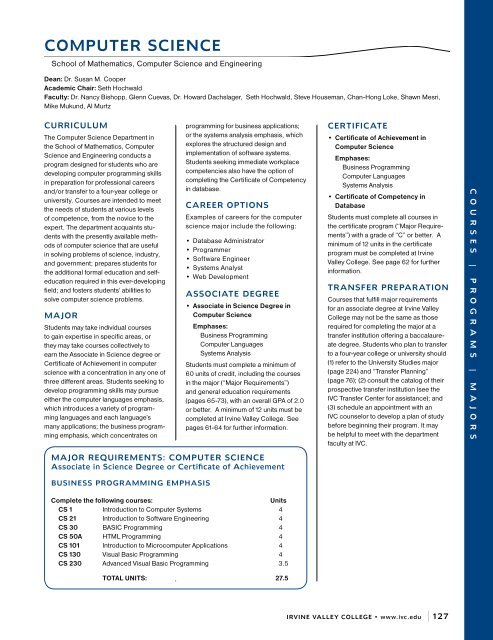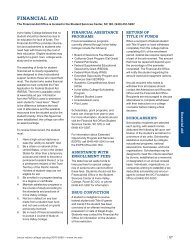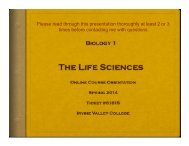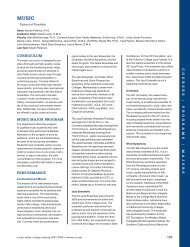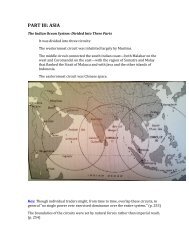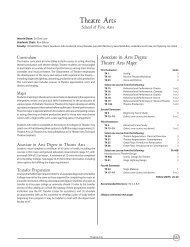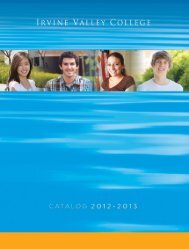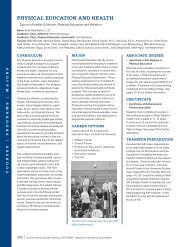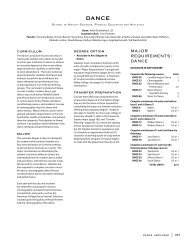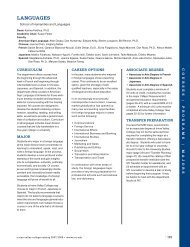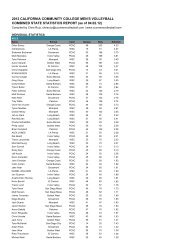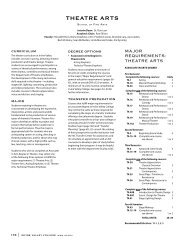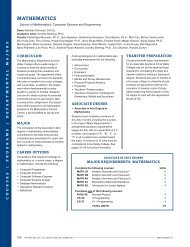COMPUtER SCIEnCE - Irvine Valley College
COMPUtER SCIEnCE - Irvine Valley College
COMPUtER SCIEnCE - Irvine Valley College
Create successful ePaper yourself
Turn your PDF publications into a flip-book with our unique Google optimized e-Paper software.
Computer Science<br />
School of Mathematics, Computer Science and Engineering<br />
Dean: Dr. Susan M. Cooper<br />
Academic Chair: Seth Hochwald<br />
Faculty: Dr. Nancy Bishopp, Glenn Cuevas, Dr. Howard Dachslager, Seth Hochwald, Steve Houseman, Chan-Hong Loke, Shawn Mesri,<br />
Mike Mukund, Al Murtz<br />
Curriculum<br />
The Computer Science Department in<br />
the School of Mathematics, Computer<br />
Science and Engineering conducts a<br />
program designed for students who are<br />
developing computer programming skills<br />
in preparation for professional careers<br />
and/or transfer to a four-year college or<br />
university. Courses are intended to meet<br />
the needs of students at various levels<br />
of competence, from the novice to the<br />
expert. The department acquaints students<br />
with the presently available methods<br />
of computer science that are useful<br />
in solving problems of science, industry,<br />
and government; prepares students for<br />
the additional formal education and selfeducation<br />
required in this ever-developing<br />
field; and fosters students’ abilities to<br />
solve computer science problems.<br />
Major<br />
Students may take individual courses<br />
to gain expertise in specific areas, or<br />
they may take courses collectively to<br />
earn the Associate in Science degree or<br />
Certificate of Achievement in computer<br />
science with a concentration in any one of<br />
three different areas. Students seeking to<br />
develop programming skills may pursue<br />
either the computer languages emphasis,<br />
which introduces a variety of programming<br />
languages and each language’s<br />
many applications; the business programming<br />
emphasis, which concentrates on<br />
programming for business applications;<br />
or the systems analysis emphasis, which<br />
explores the structured design and<br />
implementation of software systems.<br />
Students seeking immediate workplace<br />
competencies also have the option of<br />
completing the Certificate of Competency<br />
in database.<br />
career options<br />
Examples of careers for the computer<br />
science major include the following:<br />
• Database Administrator<br />
• Programmer<br />
• Software Engineer<br />
• Systems Analyst<br />
• Web Development<br />
Associate Degree<br />
• Associate in Science Degree in<br />
Computer Science<br />
Emphases:<br />
Business Programming<br />
Computer Languages<br />
Systems Analysis<br />
Students must complete a minimum of<br />
60 units of credit, including the courses<br />
in the major (“Major Requirements”)<br />
and general education requirements<br />
(pages 65-73), with an overall GPA of 2.0<br />
or better. A minimum of 12 units must be<br />
completed at <strong>Irvine</strong> <strong>Valley</strong> <strong>College</strong>. See<br />
pages 61-64 for further information.<br />
Certificate<br />
• Certificate of Achievement in<br />
Computer Science<br />
Emphases:<br />
Business Programming<br />
Computer Languages<br />
Systems Analysis<br />
• Certificate of Competency in<br />
Database<br />
Students must complete all courses in<br />
the certificate program (“Major Requirements”)<br />
with a grade of “C” or better. A<br />
minimum of 12 units in the certificate<br />
program must be completed at <strong>Irvine</strong><br />
<strong>Valley</strong> <strong>College</strong>. See page 62 for further<br />
information.<br />
Transfer Preparation<br />
Courses that fulfill major requirements<br />
for an associate degree at <strong>Irvine</strong> <strong>Valley</strong><br />
<strong>College</strong> may not be the same as those<br />
required for completing the major at a<br />
transfer institution offering a baccalaureate<br />
degree. Students who plan to transfer<br />
to a four-year college or university should<br />
(1) refer to the University Studies major<br />
(page 224) and “Transfer Planning”<br />
(page 76); (2) consult the catalog of their<br />
prospective transfer institution (see the<br />
IVC Transfer Center for assistance); and<br />
(3) schedule an appointment with an<br />
IVC counselor to develop a plan of study<br />
before beginning their program. It may<br />
be helpful to meet with the department<br />
faculty at IVC.<br />
C O U R S E S | P R O G R A M S | M A J O R S<br />
Major Requirements: Computer Science<br />
Associate in Science Degree or Certificate of Achievement<br />
Business Programming Emphasis<br />
Complete the following courses:<br />
Units<br />
CS 1 Introduction to Computer Systems 4<br />
CS 21 Introduction to Software Engineering 4<br />
CS 30 BASIC Programming 4<br />
CS 50A HTML Programming 4<br />
CS 101 Introduction to Microcomputer Applications 4<br />
CS 130 Visual Basic Programming 4<br />
CS 230 Advanced Visual Basic Programming 3.5<br />
TOTAL UNITS: 27.5<br />
<strong>Irvine</strong> <strong>Valley</strong> <strong>College</strong> • www.ivc.edu | 127
C O U R S E S | P R O G R A M S | M A J O R S<br />
Major Requirements: Computer Science<br />
Associate in Science Degree or Certificate of Achievement<br />
Computer languages Emphasis<br />
Complete the following courses:<br />
Units<br />
CS 1 Introduction to Computer Systems 4<br />
Complete any four of the following courses:<br />
CS 30 Basic Programming 4<br />
CS 34 Pascal Programming 4<br />
CS 36 C Programming 4<br />
CS 37 C++ Programming 4<br />
CS 40A Computer Organization and Assembly Language I 4<br />
CS 130 Visual Basic Programming 4<br />
CS 231 VBA Programming 3.5<br />
Complete any two of the following courses:<br />
CS 38 World Wide Web/Internet Using Java Programming 4<br />
CS 41 Data Structures 4<br />
CS 230 Advanced Visual Basic Programming 3.5<br />
CS 238 Advanced Java Programming 3.5<br />
TOTAL UNITS: 26.5-28<br />
Systems analysis Emphasis<br />
Complete the following courses:<br />
Units<br />
CS 1 Introduction to Computer Systems 4<br />
CS 21 Introduction to Software Engineering 4<br />
Complete any five of the following courses:<br />
CS 30 Basic Programming 4<br />
CS 34 Pascal Programming 4<br />
CS 36 C Programming 4<br />
CS 37 C++ Programming 4<br />
CS 38 World Wide Web/Internet Using Java Programming 4<br />
CS 41 Data Structures 4<br />
CS 130 Visual Basic Programming 4<br />
CS 230 Advanced Visual Basic Programming 3.5<br />
CS 238 Advanced Java Programming 3.5<br />
TOTAL UNITS: 27-28<br />
certificate of competency: Database<br />
Complete the following courses:<br />
Units<br />
CS 131 Database Management Programming 4<br />
CS 250A Oracle Programming I 3.5<br />
CS 250B Oracle Programming II 3.5<br />
Complete one of the following courses:<br />
CS 38 World Wide Web/Internet Using Java Programming 4<br />
CS 130 Visual Basic Programming 4<br />
CS 231 VBA Programming 3.5<br />
CS 230 Advanced Visual Basic Programming 3.5<br />
CS 231 VBA Programming 3.5<br />
TOTAL UNITS: 14.5-15<br />
Courses<br />
CS 1: Introduction to Computer<br />
Systems<br />
4 Units<br />
3 hours lecture, 3 hours lab<br />
Transfers: CSU, UC<br />
This course provides an overview of<br />
computer information systems and introduces<br />
hardware, software, networking,<br />
and Internet terminology. The course<br />
introduces Windows and Microsoft Office<br />
software, focusing particularly on spreadsheet<br />
and database applications. It also<br />
introduces programming languages and<br />
engages students in writing and executing<br />
elementary programs in Visual Basic. NR<br />
CS 6A: Computer Mathematics I<br />
3 Units<br />
3 hours lecture<br />
Transfers: CSU, UC<br />
Prerequisite: Math 2<br />
Recommended Preparation: Concurrent<br />
enrollment in Math 180<br />
This course is designed primarily for<br />
computer science majors. Areas of study<br />
include Boolean algebra, propositional<br />
calculus, and predicate calculus. Topics<br />
include truth tables, minimization, sets,<br />
relations, switching networks, digital circuits,<br />
and duality. This course is also listed<br />
as Math 30; credit will be given in either<br />
area, not both. NR<br />
CS 6B: Computer Mathematics II<br />
3 Units<br />
3 hours lecture<br />
Transfers: CSU, UC<br />
Prerequisite: Math 2<br />
Recommended Preparation: Concurrent<br />
enrollment in Math 180<br />
This course is designed primarily for<br />
computer science majors. Areas of study<br />
include permutations, combinations,<br />
binomial coefficients, recurrence relations,<br />
graph theory, generating functions,<br />
and probability theory. This course is also<br />
listed as Math 31; credit will be given in<br />
either area, not both. NR<br />
CS 21: Introduction to Software<br />
Engineering<br />
4 Units<br />
3 hours lecture, 3 hours lab<br />
Transfers: CSU, UC<br />
Prerequisite: CS 34, 36, 37 or 38<br />
This course covers the specification,<br />
design, implementation, testing, and<br />
documentation of a software system. The<br />
course stresses the role of effective oral<br />
and written communication of concepts,<br />
proper programming style, well-planned<br />
testing, and group cooperation in creating<br />
a successful system. NR<br />
128 | Catalog 2006-2007 • computer science
CS 30: BASIC Programming<br />
4 Units<br />
3 hours lecture, 3 hours lab<br />
Transfers: CSU, UC<br />
This beginning-level course in computer<br />
programming introduces fundamental programming<br />
concepts and skills using the<br />
BASIC programming language. Students<br />
will exercise problem-solving skills in a<br />
wide range of applications as they analyze<br />
problems, develop algorithms, design and<br />
implement programs, and resolve program<br />
errors. NR<br />
CS 34: Pascal Programming<br />
4 Units<br />
3 hours lecture, 3 hours lab<br />
Transfers: CSU, UC<br />
Recommended Preparation: Some programming<br />
experience would be helpful.<br />
This course introduces the Pascal programming<br />
language. Topics include data types,<br />
control structures, procedures, functions<br />
and parameter passing, loops, arrays,<br />
records, text and binary files, recursion,<br />
pointers, and an introduction to object-oriented<br />
programming. Students will exercise<br />
problem-solving skills in a wide range of<br />
applications as they analyze problems,<br />
develop algorithms, design and implement<br />
programs, and resolve program errors. NR<br />
CS 36: C Programming<br />
4 Units<br />
3 hours lecture, 3 hours lab<br />
Transfers: CSU, UC<br />
Recommended Preparation: Some programming<br />
experience would be helpful.<br />
This course introduces the C programming<br />
language. Topics include data types,<br />
control structures, functions and parameter<br />
passing, loops, arrays, structures, text<br />
and binary files, recursion, and pointers.<br />
Students will exercise problem-solving<br />
skills in a wide range of applications as<br />
they analyze problems, develop algorithms,<br />
design and implement programs,<br />
and resolve program errors. NR<br />
CS 37: C++ Programming<br />
4 Units<br />
3 hours lecture, 3 hours lab<br />
Transfers: CSU, UC<br />
Prerequisite: CS 36<br />
This course introduces the C++ programming<br />
language. Topics include input and<br />
output statements, file handling, functions<br />
and parameter passing, function pointers,<br />
overloading functions, templates, pointers<br />
including the “this” pointer, object-oriented<br />
programming principles, classes,<br />
constructors and destructors, friends,<br />
operator overloading, inheritance, polymorphism,<br />
and exception handling. NR<br />
CS 38: World Wide Web/Internet<br />
Using Java Programming<br />
4 Units<br />
3 hours lecture, 3 hours lab<br />
Transfers: CSU, UC<br />
Recommended Preparation: CS 36 or 37<br />
This course focuses on application development<br />
using Java. The course covers Java<br />
syntax and operating procedures, as well<br />
as design and programming techniques for<br />
object-oriented programs. Additional topics<br />
include Applet programming in Java, fonts,<br />
colors, multithreading, streams, and native<br />
methods and libraries. NR<br />
CS 39: C# Programming Using<br />
Microsoft.NET<br />
4 Units<br />
3 hours lecture, 3 hours lab<br />
Transfers: CSU, UC<br />
Recommended Preparation: CS 37 and<br />
CS 38<br />
In this course, students will use the<br />
C# programming language to create<br />
Windows, web, and database applications.<br />
Topics include C# fundamentals,<br />
object-oriented programming, strings,<br />
graphics, graphical-user-interface (GUI)<br />
components, exception handling, multithreading,<br />
multimedia, file processing,<br />
prepackaged data structures, and database<br />
processing. NR<br />
CS 40A: Computer Organization<br />
and Assembly Language I<br />
4 Units<br />
3 hours lecture, 3 hours lab<br />
Transfers: CSU, UC<br />
Prerequisite: CS 34, 36, 37 or 38<br />
This course introduces computer organization<br />
focusing especially on assembly<br />
language programming. Topics include<br />
finite-precision arithmetic, floating-point<br />
architecture, and Boolean algebra. The<br />
course also discusses conventional<br />
machine language and its corresponding<br />
assembly language notation. NR<br />
CS 40B: Computer Organization<br />
and Assembly Language II<br />
4 Units<br />
3 hours lecture, 3 hours lab<br />
Transfers: CSU, UC<br />
Prerequisite: CS 40A<br />
This course is a continuation of Computer<br />
Science 40A. Students will further study<br />
computer organization and assembly<br />
language and the differences among<br />
assembly languages from one family of<br />
computers to another. The course will also<br />
examine microprogramming, operating<br />
systems, and multilevel machines. NR<br />
CS 41: Data Structures<br />
4 Units<br />
3 hours lecture, 3 hours lab<br />
Transfers: CSU, UC<br />
Prerequisite: CIS 34, 36, 37 or 38<br />
This course examines the basic concepts<br />
of data structures and related algorithms.<br />
Students use arrays, structures, stacks,<br />
queues, linked lists, trees, graphs, and<br />
tables to design algorithms and then write<br />
complete programs to implement these<br />
algorithms. Recursion, searching, sorting,<br />
and timing and space analyses for<br />
algorithms will also be discussed. NR<br />
CS 50A: HTML Programming<br />
4 Units<br />
3 hours lecture, 3 hours lab<br />
Transfers: CSU, UC<br />
Recommended Preparation: CS 101<br />
This course focuses on developing World<br />
Wide Web pages for the Internet using<br />
hypertext markup language (HTML). The<br />
course investigates the structure of the<br />
web, the fundamentals of writing HTML<br />
code, and the creation of a web site.<br />
Topics include creating hypertext links,<br />
working with design elements, creating<br />
and controlling text and graphic tables,<br />
using frames, building web page forms,<br />
and working with Common Gateway<br />
Interface (CGI) scripts. NR<br />
CS 50B: Dynamic HTML<br />
Programming and Scripting<br />
4 Units<br />
3 hours lecture, 3 hours lab<br />
Transfers: CSU<br />
Recommended Preparation: CS 50A<br />
This course focuses on developing,<br />
modifying, and documenting dynamic web<br />
pages. The course reviews HTML and<br />
introduces a variety of Internet tools and<br />
scripting languages, including, but not<br />
limited to CSS (Cascading Style Sheets),<br />
JavaScript, Dynamic HTML, XHTML, and<br />
VBScript (Visual Basic Scripting), and an<br />
introduction to XML (Extensible Markup<br />
Language). No UC credit. NR<br />
CS 60: UNIX Operating System<br />
4 Units<br />
3 hours lecture, 3 hours lab<br />
Transfers: CSU, UC credit pending<br />
This course covers the UNIX operating<br />
system and its uses and capabilities.<br />
Students will program computer functions<br />
and perform a variety of computer operations<br />
in the UNIX environment. Computer<br />
Science 60 was formerly Computer<br />
Science 142. NR<br />
C O U R S E S | P R O G R A M S | M A J O R S<br />
<strong>Irvine</strong> <strong>Valley</strong> <strong>College</strong> • www.ivc.edu | 129
C O U R S E S | P R O G R A M S | M A J O R S<br />
CS 101: Introduction to<br />
Microcomputer Applications<br />
4 Units<br />
3 hours lecture, 3 hours lab<br />
Transfers: CSU<br />
This course introduces the purpose,<br />
uses, characteristics, capabilities, and<br />
operations of microcomputer application<br />
packages. The course uses a case-based<br />
approach to present word processing,<br />
spreadsheet, database, presentation<br />
graphics, communications, and financial<br />
software. Students will create web pages<br />
using various applications and upload<br />
work to a web server. NR<br />
CS 130: Visual Basic<br />
Programming<br />
4 Units<br />
3 hours lecture, 3 hours lab<br />
Transfers: CSU<br />
Recommended Preparation: CS 30<br />
This course focuses on the development<br />
of applications using Visual Basic. The<br />
course covers Visual Basic syntax and<br />
operating procedures, as well as design<br />
and programming techniques for eventdriven<br />
and object-oriented programs in<br />
Visual Basic. NR<br />
CS 131: Database Management<br />
Programming<br />
4 Units<br />
3 hours lecture. 3 hours lab<br />
Transfers: CSU<br />
This course focuses on the principles<br />
of relational database design, programming<br />
and implementation. Topics covered<br />
include Database Concepts, Modeling,<br />
Design, and Standard Query Language<br />
(SQL); transaction management; concurrency<br />
control; client/server systems; data<br />
warehousing; and databases and the<br />
Internet. NR<br />
CS 230: Advanced Visual Basic<br />
Programming<br />
3.5 Units<br />
3 hours lecture, 1.5 hours lab<br />
Recommended Preparation: CS 130<br />
This course focuses on application development<br />
using the advanced features of<br />
Visual Basic. Topics include database<br />
manipulation, the data control, the JET<br />
engine, Structured Query Language<br />
(SQL), Crystal Reports, objects and<br />
classes, ActiveX components. NR<br />
CS 231: VBA Programming<br />
3.5 Units<br />
3 hours lecture, 1.5 hours lab<br />
Recommended Preparation: CS 1 and<br />
basic knowledge of Microsoft applications.<br />
This course focuses on application<br />
development using VBA (Visual Basic for<br />
Applications) with Microsoft Office and<br />
non-Microsoft products. Topics include<br />
VBA syntax; program design; programming<br />
techniques using sequence, selection,<br />
repetition program structures, dialog<br />
boxes and automation; and distribution of<br />
custom applications. NR<br />
CS 232: ASP Programming<br />
for the Internet<br />
3.5 Units<br />
3 hours lecture, 1.5 hours lab<br />
Recommended Preparation: CS 50A<br />
This course introduces students to the<br />
Active Server Pages (ASP) programming<br />
language on the World Wide Web. Major<br />
topics include client/server methodologies,<br />
ASP objects, installable components,<br />
and the use of ASP to display and<br />
retrieve data from databases. NR<br />
CS 238: Advanced JAVA<br />
Programming<br />
3.5 Units<br />
3 hours lecture, 1.5 hours lab<br />
Prerequisite: CS 38<br />
This course is for programmers and developers<br />
who are already familiar with the<br />
basic structure and syntax of the Java programming<br />
language, and who have a need<br />
to acquire advanced proficiency in developing<br />
complex, production-level applications<br />
using Java. This course covers<br />
features such as multithreading, streams,<br />
files, data structures, networking, database<br />
connectivity, remote objects, GUI<br />
components, and event handling. NR<br />
CS 250A: Oracle Programming I<br />
3.5 Units<br />
3 hours lecture, 1.5 hours lab<br />
Recommended Preparation: CS 1<br />
This course covers the Oracle client/<br />
server database development environment.<br />
The course presents several Oracle<br />
utilities, including SQL Plus, Query<br />
Builder, and Procedure Builder, as well as<br />
the SQL and PL/SQL programming languages.<br />
NR<br />
CS 250B: Oracle Programming II<br />
3.5 Units<br />
3 hours lecture, 1.5 hours lab<br />
Prerequisite: CS 250A<br />
This course covers the use of Oracle<br />
Developer Forms and Oracle Reports<br />
to build interactive GUI (Graphical User<br />
Interface) applications. Topics include<br />
user input items; using wizards and the<br />
Object Navigator; employing blocks,<br />
triggers, reusable objects and codes;<br />
creating report templates; and embedding<br />
charts in reports. NR<br />
COMPUTER SCIENCE<br />
(SPECIAL SERVICES)<br />
CISS 320: Adaptive<br />
Computer Assessment<br />
1.5 Units<br />
1.5 hours lecture<br />
This course is designed to provide physically<br />
limited students an overview of adaptive<br />
computer devices and to assess each<br />
student’s individual needs. Appropriate<br />
modifications will be made to accommodate<br />
disabled students in computer<br />
courses. R-E-1<br />
COMPUTER LAB<br />
CS 205L: Computer-Aided<br />
Drafting Access Laboratory<br />
1 Unit<br />
3 hours learning center<br />
Corequisite: Dr. 50, 100, 101, 102, 160; or<br />
Engr. 23, 183 or 184; or Engt. 140<br />
This course allows students taking drafting<br />
CAD courses access to applications software<br />
to support their coursework. R-E-3<br />
130 | Catalog 2006-2007 • computer science


